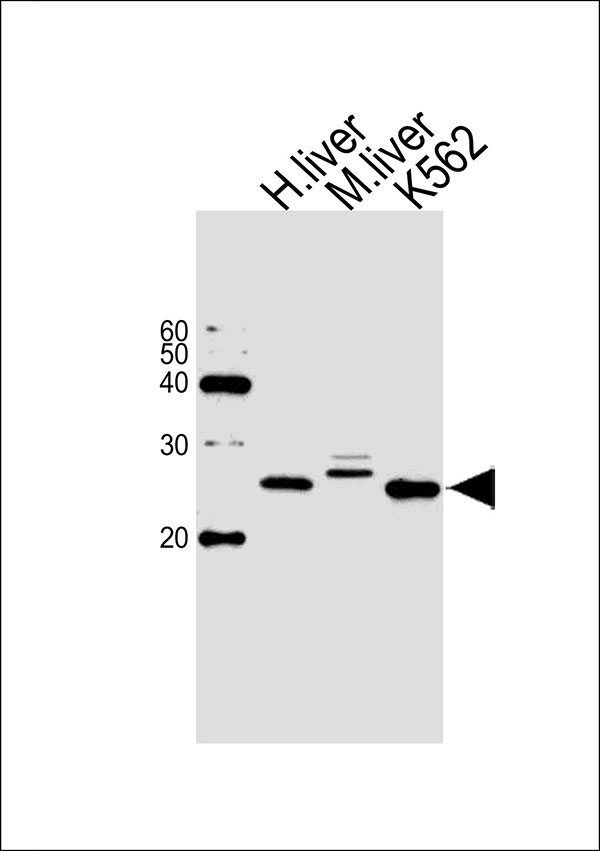BLVRB Antibody (C-term)
Purified Rabbit Polyclonal Antibody (Pab)
- 产品详情
- 实验流程
- 背景知识
Application
| WB |
|---|---|
| Primary Accession | P30043 |
| Other Accession | Q923D2, P52556 |
| Reactivity | Human, Mouse |
| Predicted | Bovine |
| Host | Rabbit |
| Clonality | polyclonal |
| Calculated MW | 22119 Da |
| Isotype | Rabbit IgG |
| Antigen Source | HUMAN |
| Gene ID | 645 |
|---|---|
| Antigen Region | 161-175 aa |
| Other Names | Flavin reductase (NADPH), FR, Biliverdin reductase B, BVR-B, Biliverdin-IX beta-reductase, Green heme-binding protein, GHBP, NADPH-dependent diaphorase, NADPH-flavin reductase, FLR, BLVRB, FLR |
| Dilution | WB~~1:1000 |
| Target/Specificity | This BLVRB antibody is generated from a rabbit immunized with a KLH conjugated synthetic peptide between 161-175 amino acids from the C-terminal region of human BLVRB. |
| Format | Purified polyclonal antibody supplied in PBS with 0.09% (W/V) sodium azide. This antibody is purified through a protein A column, followed by peptide affinity purification. |
| Storage | Maintain refrigerated at 2-8°C for up to 2 weeks. For long term storage store at -20°C in small aliquots to prevent freeze-thaw cycles. |
| Precautions | BLVRB Antibody (C-term) is for research use only and not for use in diagnostic or therapeutic procedures. |
| Name | BLVRB (HGNC:1063) |
|---|---|
| Function | Enzyme that can both act as a NAD(P)H-dependent reductase and a S-nitroso-CoA-dependent nitrosyltransferase (PubMed:10620517, PubMed:18241201, PubMed:27207795, PubMed:38056462, PubMed:7929092). Promotes fetal heme degradation during development (PubMed:10858451, PubMed:18241201, PubMed:7929092). Also expressed in adult tissues, where it acts as a regulator of hematopoiesis, intermediary metabolism (glutaminolysis, glycolysis, TCA cycle and pentose phosphate pathway) and insulin signaling (PubMed:27207795, PubMed:29500232, PubMed:38056462). Has a broad specificity oxidoreductase activity by catalyzing the NAD(P)H-dependent reduction of a variety of flavins, such as riboflavin, FAD or FMN, biliverdins, methemoglobin and PQQ (pyrroloquinoline quinone) (PubMed:10620517, PubMed:18241201, PubMed:7929092). Contributes to fetal heme catabolism by catalyzing reduction of biliverdin IXbeta into bilirubin IXbeta in the liver (PubMed:10858451, PubMed:18241201, PubMed:7929092). Biliverdin IXbeta, which constitutes the major heme catabolite in the fetus is not present in adult (PubMed:10858451, PubMed:18241201, PubMed:7929092). Does not reduce bilirubin IXalpha (PubMed:10858451, PubMed:18241201, PubMed:7929092). Can also reduce the complexed Fe(3+) iron to Fe(2+) in the presence of FMN and NADPH (PubMed:10620517). Acts as a protein nitrosyltransferase by catalyzing nitrosylation of cysteine residues of target proteins, such as HMOX2, INSR and IRS1 (PubMed:38056462). S- nitroso-CoA-dependent nitrosyltransferase activity is mediated via a 'ping-pong' mechanism: BLVRB first associates with both S-nitroso-CoA and protein substrate, nitric oxide group is then transferred from S- nitroso-CoA to Cys-109 and Cys-188 residues of BLVRB and from S- nitroso-BLVRB to the protein substrate (PubMed:38056462). Inhibits insulin signaling by mediating nitrosylation of INSR and IRS1, leading to their inhibition (PubMed:38056462). |
| Cellular Location | Cytoplasm |
| Tissue Location | Predominantly expressed in liver and erythrocytes (PubMed:7929092). At lower levels in heart, lung, adrenal gland and cerebrum (PubMed:7929092). Expressed in adult red blood cells (PubMed:29932944). |
For Research Use Only. Not For Use In Diagnostic Procedures.
Provided below are standard protocols that you may find useful for product applications.
BACKGROUND
Broad specificity oxidoreductase that catalyzes the NADPH-dependent reduction of a variety of flavins, such as riboflavin, FAD or FMN, biliverdins, methemoglobin and PQQ (pyrroloquinoline quinone). Contributes to heme catabolism and metabolizes linear tetrapyrroles. Can also reduce the complexed Fe(3+) iron to Fe(2+) in the presence of FMN and NADPH. In the liver, converts biliverdin to bilirubin.
REFERENCES
Chikuba K.,et al.Biochem. Biophys. Res. Commun. 198:1170-1176(1994).
Komuro A.,et al.Biol. Pharm. Bull. 19:796-804(1996).
Ota T.,et al.Nat. Genet. 36:40-45(2004).
Grimwood J.,et al.Nature 428:529-535(2004).
Mural R.J.,et al.Submitted (JUL-2005) to the EMBL/GenBank/DDBJ databases.
终于等到您。ABCEPTA(百远生物)抗体产品。
点击下方“我要评价 ”按钮提交您的反馈信息,您的反馈和评价是我们最宝贵的财富之一,
我们将在1-3个工作日内处理您的反馈信息。
如有疑问,联系:0512-88856768 tech-china@abcepta.com.























 癌症的基本特征包括细胞增殖、血管生成、迁移、凋亡逃避机制和细胞永生等。找到癌症发生过程中这些通路的关键标记物和对应的抗体用于检测至关重要。
癌症的基本特征包括细胞增殖、血管生成、迁移、凋亡逃避机制和细胞永生等。找到癌症发生过程中这些通路的关键标记物和对应的抗体用于检测至关重要。 为您推荐一个泛素化位点预测神器——泛素化分析工具,可以为您的蛋白的泛素化位点作出预测和评分。
为您推荐一个泛素化位点预测神器——泛素化分析工具,可以为您的蛋白的泛素化位点作出预测和评分。 细胞自噬受体图形绘图工具为你的蛋白的细胞受体结合位点作出预测和评分,识别结合到自噬通路中的蛋白是非常重要的,便于让我们理解自噬在正常生理、病理过程中的作用,如发育、细胞分化、神经退化性疾病、压力条件下、感染和癌症。
细胞自噬受体图形绘图工具为你的蛋白的细胞受体结合位点作出预测和评分,识别结合到自噬通路中的蛋白是非常重要的,便于让我们理解自噬在正常生理、病理过程中的作用,如发育、细胞分化、神经退化性疾病、压力条件下、感染和癌症。






